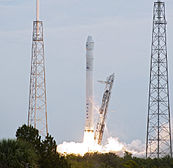SpaceX Dragon 1

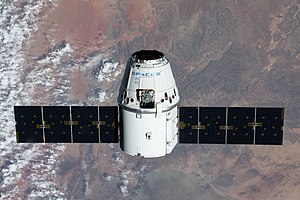 Dragon approaching the International Space Station during the CRS-20 mission, the last flight of the Dragon 1 | |||
| Manufacturer | SpaceX | ||
|---|---|---|---|
| Country of origin | United States | ||
| Operator | SpaceX | ||
| Applications | ISS logistics | ||
| Specifications | |||
| Dry mass | 4,201 kg (9,262 lb)[1] | ||
| Payload capacity | |||
| Crew capacity | 0 | ||
| Volume | |||
| Dimensions | |||
| Length | 6.1 m (20 ft)[1] | ||
| Diameter | 3.7 m (12 ft)[1] | ||
| Production | |||
| Status | Retired | ||
| Built | 14 | ||
| Retired | 13 | ||
| Lost | 1 | ||
| Maiden launch |
| ||
| Last launch | 7 March 2020 | ||
| Related spacecraft | |||
| Derivatives |
| ||
| Thruster details | |||
| Powered by | 18 × Draco | ||
| Propellant | N2O4 / CH6N2[6] | ||
| |||
| Part of a series on |
| Private spaceflight |
|---|
 |
| Active companies |
| Active vehicles |
| Contracts and programs |
| Related |
SpaceX Dragon 1 is a class of fourteen partially reusable cargo spacecraft developed by SpaceX, an American private space transportation company. The spacecraft flew 23 missions between 2010 and 2020. Dragon was launched into orbit by the company's Falcon 9 launch vehicle to resupply the International Space Station (ISS). It was succeeded by the Dragon 2 spacecraft which has both crewed and cargo versions.
During its maiden flight in December 2010, Dragon became the first commercially built and operated spacecraft to be recovered successfully from orbit. On 25 May 2012, Dragon became the first commercial spacecraft to successfully rendezvous with and attach to the ISS.[7][8][9] SpaceX contracted to deliver cargo to the ISS under NASA's Commercial Resupply Services program, and Dragon began regular cargo flights in October 2012.[10][11][12][13] With the Dragon spacecraft and the Northrop Grumman’s Cygnus, NASA sought to increase its partnerships with domestic commercial aviation and aeronautics industry.[14]
On 3 June 2017, the C106 capsule, largely assembled from previously flown components from the CRS-4 mission in September 2014, was launched again for the first time on CRS-11, after being refurbished.[15]
The last flight of the Dragon 1 spacecraft launched 7 March 2020 (UTC) on cargo resupply mission (CRS-20) to International Space Station (ISS). This was the last mission of SpaceX's first Commercial Resupply Services (CRS-1) contract, and marked the retirement of the Dragon 1 fleet. Further SpaceX commercial resupply flights to ISS under the second Commercial Resupply Services (CRS-2) program use the Cargo Dragon variant of the Dragon 2 spacecraft, which is capable of fully-automated docking with the ISS.[16]
History
[edit]SpaceX began developing the Dragon spacecraft in late 2004, making a public announcement in 2006 with a plan of entering service in 2009.[17] Also in 2006, SpaceX won a contract to use Dragon for commercial resupply services to the International Space Station for the American federal space agency, NASA.[18]
NASA ISS resupply contract
[edit]Commercial Orbital Transportation Services
[edit]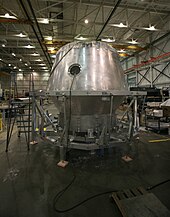
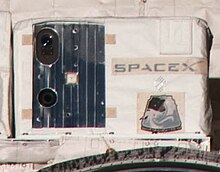
In 2005, NASA solicited proposals for a commercial ISS resupply cargo vehicle to replace the then-soon-to-be-retired Space Shuttle, through its Commercial Orbital Transportation Services (COTS) development program. The Dragon space capsule was a part of SpaceX's proposal, submitted to NASA in March 2006. SpaceX's COTS proposal was issued as part of a team, which also included MD Robotics, the Canadian company that had built the ISS's Canadarm2.
On 18 August 2006, NASA announced that SpaceX had been chosen, along with Kistler Aerospace, to develop cargo launch services for the ISS.[18] The initial plan called for three demonstration flights of SpaceX's Dragon spacecraft to be conducted between 2008 and 2010.[19][20] SpaceX and Kistler were to receive up to US$278 million and US$207 million respectively,[20] if they met all NASA milestones, but Kistler failed to meet its obligations, and its contract was terminated in 2007.[21] NASA later re-awarded Kistler's contract to Orbital Sciences Corporation.[21][22]
Commercial Resupply Services Phase 1
[edit]On 23 December 2008, NASA awarded a US$1.6 billion Commercial Resupply Services (CRS-1) contract to SpaceX, with contract options that could potentially increase the maximum contract value to US$3.1 billion.[23] The contract called for 12 flights, with an overall minimum of 20,000 kilograms (44,000 lb) of cargo to be carried to the ISS.[23]
On 23 February 2009, SpaceX announced that its chosen phenolic-impregnated carbon ablator heat shield material, PICA-X, had passed heat stress tests in preparation for Dragon's maiden launch.[24][25] The primary proximity-operations sensor for the Dragon spacecraft, the DragonEye, was tested in early 2009 during the STS-127 mission, when it was mounted near the docking port of the Space Shuttle Endeavour and used while the Shuttle approached the International Space Station. The DragonEye's lidar and thermography (thermal imaging) abilities were both tested successfully.[26][27] The COTS UHF Communication Unit (CUCU) and Crew Command Panel (CCP) were delivered to the ISS during the late 2009 STS-129 mission.[28] The CUCU allows the ISS to communicate with Dragon and the CCP allows ISS crew members to issue basic commands to Dragon.[28] In summer 2009, SpaceX hired former NASA astronaut Ken Bowersox as vice president of their new Astronaut Safety and Mission Assurance Department, in preparation for crews using the spacecraft.[29]
As a condition of the NASA CRS contract, SpaceX analyzed the orbital radiation environment on all Dragon systems, and how the spacecraft would respond to spurious radiation events. That analysis and the Dragon design – which uses an overall Fault tolerance triple redundant computer architecture, rather than individual radiation hardening of each computer processor – was reviewed by independent experts before being approved by NASA for the cargo flights.[30]
During March 2015, it was announced that SpaceX had been awarded an additional three missions under Commercial Resupply Services Phase 1.[31] These additional missions are SpaceX CRS-13, SpaceX CRS-14 and SpaceX CRS-15 and would cover the cargo needs of 2017. On 24 February 2016, SpaceNews disclosed that SpaceX had been awarded a further five missions under Commercial Resupply Services Phase 1.[32] This additional tranche of missions had SpaceX CRS-16 and SpaceX CRS-17 manifested for FY2017 while SpaceX CRS-18, SpaceX CRS-19 and SpaceX CRS-20 and were notionally manifested for FY2018.
Commercial Resupply Services Phase 2
[edit]The Commercial Resupply Services-2 (CRS-2) contract definition and solicitation period commenced in 2014. In January 2016, NASA awarded contracts to SpaceX, Orbital ATK, and Sierra Nevada Corporation for a minimum of six launches each, with missions planned until at least 2024. The maximum potential value of all the contracts was announced as US$14 billion, but the minimum requirements would be considerably less.[33] No further financial information was disclosed.
CRS-2 launches began in late 2019.
Demonstration flights
[edit]
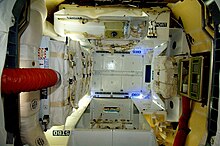

The first flight of the Falcon 9, a private flight, occurred in June 2010 and launched a stripped-down version of the Dragon capsule. This Dragon Spacecraft Qualification Unit had initially been used as a ground test bed to validate several of the capsule's systems. During the flight, the unit's primary mission was to relay aerodynamic data captured during the ascent.[34][35] It was not designed to survive re-entry, and did not.
NASA contracted for three test flights from SpaceX, but later reduced that number to two. The first Dragon spacecraft launched on its first mission – contracted to NASA as COTS Demo Flight 1 – on 8 December 2010, and was successfully recovered following re-entry to Earth's atmosphere. The mission also marked the second flight of the Falcon 9 launch vehicle.[36] The DragonEye sensor flew again on STS-133 in February 2011 for further on-orbit testing.[37] In November 2010, the Federal Aviation Administration (FAA) had issued a re-entry license for the Dragon capsule, the first such license ever awarded to a commercial vehicle.[38]
The second Dragon flight, also contracted to NASA as a demonstration mission, launched successfully on 22 May 2012, after NASA had approved SpaceX's proposal to combine the COTS 2 and 3 mission objectives into a single Falcon 9/Dragon flight, renamed COTS 2+.[5][39] Dragon conducted orbital tests of its navigation systems and abort procedures, before being grappled by the ISS' Canadarm2 and successfully berthing with the station on 25 May 2012 to offload its cargo.[7][40][41][42][43] Dragon returned to Earth on 31 May 2012, landing as scheduled in the Pacific Ocean, and was again successfully recovered.[44][45]
On 23 August 2012, NASA Administrator Charles Bolden announced that SpaceX had completed all required milestones under the COTS contract, and was cleared to begin operational resupply missions to the ISS.[46]
Returning research materials from orbit
[edit]Dragon spacecraft can return 3,500 kilograms (7,700 lb) of cargo to Earth, which can be all unpressurized disposal mass, or up to 3,000 kilograms (6,600 lb) of pressurized cargo, from the ISS,[2] and is the only current spacecraft capable of returning to Earth with a significant amount of cargo. Other than the Russian Soyuz crew capsule, Dragon is the only currently operating spacecraft designed to survive re-entry. Because Dragon allows for the return of critical materials to researchers in as little as 48 hours from splashdown, it opens the possibility of new experiments on ISS that can produce materials for later analysis on ground using more sophisticated instrumentation. For example, CRS-12 returned mice that have spent time in orbit which will help give insight into how microgravity impacts blood vessels in both the brain and eyes, and in determining how arthritis develops.[47]
Operational flights
[edit]Dragon was launched on its first operational CRS flight on 8 October 2012,[10] and completed the mission successfully on 28 October 2012.[48] NASA initially contracted SpaceX for 12 operational missions, and later extended the CRS contract with 8 more flights, bringing the total to 20 launches until 2019. In 2016, a new batch of 6 missions under the CRS-2 contract was assigned to SpaceX; those missions are scheduled to be launched between 2020 and 2024.
Reuse of previously-flown capsules
[edit]CRS-11, SpaceX's eleventh CRS mission, was successfully launched on 3 June 2017 from Kennedy Space Center LC-39A, being the 100th mission to be launched from that pad. This mission was the first to re-fly a previously flown Dragon capsule. This mission delivered 2,708 kilograms[49] of cargo to the International Space Station, including Neutron Star Interior Composition Explorer (NICER).[50] The first stage of the Falcon 9 launch vehicle landed successfully at Landing Zone 1. This mission launched for the first time a refurbished Dragon capsule,[51] serial number C106, which had flown in September 2014 on the CRS-4 mission,[52] and was the first time since 2011 a reused spacecraft arrived at the ISS.[53] Gemini SC-2 capsule is the only other reused capsule, but it was only reflown suborbitally in 1966.
CRS-12, SpaceX's twelfth CRS mission, was successfully launched on the first "Block 4" version of the Falcon 9 on 14 August 2017 from Kennedy Space Center LC-39A at the first attempt. This mission delivered 2,349 kilograms (5,179 lb) of pressurized mass and 961 kilograms (2,119 lb) unpressurized. The external payload manifested for this flight was the CREAM cosmic-ray detector. This was the last flight of a newly built Dragon capsule; further missions used refurbished spacecraft.[54]
CRS-13, SpaceX's thirteenth CRS mission, was the second use of a previously flown Dragon capsule, but the first time in concordance with a reused first-stage booster. It was successfully launched on 15 December 2017 from Cape Canaveral Air Force Station Space Launch Complex 40 at the first attempt. This was the first launch from SLC-40 since the AMOS-6 pad anomaly. The booster was the previously flown core from the CRS-11 mission. This mission delivered 1,560 kilograms (3,440 lb) of pressurized mass and 645 kilograms (1,422 lb) unpressurized. It returned from orbit and splashdown on 13 January 2018, making it the first space capsule to be reflown to orbit more than once.[55]
CRS-14, SpaceX's fourteenth CRS mission, was the third reuse of a previously flown Dragon capsule. It was successfully launched on 2 April 2018 from Cape Canaveral Air Force Station SLC-40. It was successfully berthed to the ISS on 4 April 2018 and remained berthed for a month before returning cargo and science experiments back to Earth.
CRS-15, CRS-16, CRS-17, CRS-18, CRS-19, and CRS-20 were all flown with previously flown capsules.
Crewed development program
[edit]In 2006, Elon Musk stated that SpaceX had built "a prototype flight crew capsule, including a thoroughly tested 30-man-day life-support system".[17] A video simulation of the launch escape system's operation was released in January 2011.[56] Musk stated in 2010 that the developmental cost of a crewed Dragon and Falcon 9 would be between US$800 million and US$1 billion.[57] In 2009 and 2010, Musk suggested on several occasions that plans for a crewed variant of the Dragon were proceeding and had a two-to-three-year timeline to completion.[58][59] SpaceX submitted a bid for the third phase of CCDev, CCiCap.[60][61] This evolved into the Crew dragon variant of the SpaceX Dragon 2.
Development funding
[edit]In 2014, SpaceX released the total combined development costs for both the Falcon 9 launch vehicle and the Dragon capsule. NASA provided US$396 million while SpaceX provided over US$450 million to fund both development efforts.[62]
Production
[edit]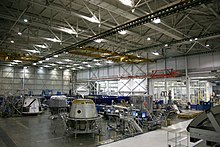
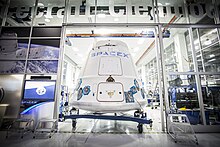
In December 2010, the SpaceX production line was reported to be manufacturing one new Dragon spacecraft and Falcon 9 rocket every three months. Elon Musk stated in a 2010 interview that he planned to increase production turnover to one Dragon every six weeks by 2012.[63] Composite materials are extensively used in the spacecraft's manufacture to reduce weight and improve structural strength.[64]
By September 2013, SpaceX total manufacturing space had increased to nearly 1,000,000 square feet (93,000 m2) and the factory had six Dragons in various stages of production. SpaceX published a photograph showing the six, including the next four NASA Commercial Resupply Services (CRS-1) mission Dragons (CRS-3, CRS-4, CRS-5, CRS-6) plus the drop-test Dragon, and the pad-abort Dragon weldment for commercial crew program.[65]
Design
[edit]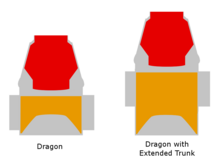
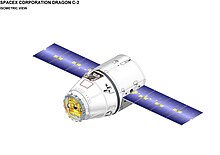
The Dragon spacecraft consists of a nose-cone cap, a conventional blunt-cone ballistic capsule, and an unpressurized cargo-carrier trunk equipped with two solar arrays.[66] The capsule uses a PICA-X heat shield, based on a proprietary variant of NASA's Phenolic impregnated carbon ablator (PICA) material, designed to protect the capsule during Earth atmospheric entry, even at high return velocities from Lunar and Martian missions.[67][68][69] The Dragon capsule is re-usable, and can fly multiple missions.[66] The trunk is not recoverable; it separates from the capsule before re-entry and burns up in Earth's atmosphere.[70] The trunk section, which carries the spacecraft's solar panels and allows the transport of unpressurized cargo to the ISS, was first used for cargo on the SpaceX CRS-2 mission.
The spacecraft is launched atop a Falcon 9 booster.[71] The Dragon capsule is equipped with 18 Draco thrusters.[68] During its initial cargo and crew flights, the Dragon capsule will land in the Pacific Ocean and be returned to the shore by ship.[72]
For the ISS Dragon cargo flights, the ISS's Canadarm2 grapples its Flight-Releasable Grapple Fixture and berths Dragon to the station's US Orbital Segment using a Common Berthing Mechanism (CBM).[73] The CRS Dragon does not have an independent means of maintaining a breathable atmosphere for astronauts and instead circulates in fresh air from the ISS.[74] For typical missions, Dragon is planned to remain berthed to the ISS for about 30 days.[75]
The Dragon capsule can transport 3,310 kilograms (7,300 lb) of cargo, which can be all pressurized, all unpressurized, or a combination thereof. It can return to Earth 3,310 kilograms (7,300 lb), which can be all unpressurized disposal mass, or up to 3,310 kilograms (7,300 lb) of return pressurized cargo, driven by parachute limitations. There is a volume constraint of 14 cubic metres (490 cu ft) trunk unpressurized cargo and 11.2 cubic metres (400 cu ft) of pressurized cargo (up or down).[76] The trunk was first used operationally on the Dragon's CRS-2 mission in March 2013.[77] Its solar arrays produce a peak power of 4 kW.[6]
The design was modified beginning with the fifth Dragon flight on the SpaceX CRS-3 mission to the ISS in March 2014. While the outer mold line of the Dragon was unchanged, the avionics and cargo racks were redesigned to supply substantially more electrical power to powered cargo devices, including the GLACIER freezer module and MERLIN freezer module freezer modules for transporting critical science payloads.[78]
Variants and derivatives
[edit]DragonLab
[edit]SpaceX planned to fly the Dragon spacecraft in a free-flying configuration, known as DragonLab.[66] Its subsystems include propulsion, power, thermal and environmental control (ECLSS), avionics, communications, thermal protection, flight software, guidance and navigation systems, and entry, descent, landing, and recovery gear.[4] It has a total combined upmass of 6,000 kilograms (13,000 lb) upon launch, and a maximum downmass of 3,000 kilograms (6,600 lb) when returning to Earth.[4] In November 2014, there were two DragonLab missions listed on the SpaceX launch manifest: one in 2016 and another in 2018.[79] However, these missions were removed from the manifest in early 2017, with no official SpaceX statement.[80] The American Biosatellites once performed similar uncrewed payload-delivery functions, and the Russian Bion satellites still continue to do so.
List of vehicles
[edit]| Serial | Name | Type | Status | Flights | Time in flight | Notes | Cat. |
|---|---|---|---|---|---|---|---|
| C101 | N/A | Prototype | Retired | 1 | 3h, 19m | On display at SpaceX's headquarters. | |
| C102 | N/A | Production | Retired | 1 | 9d, 7h, 57m | On display at Kennedy Space Center Visitor Complex. | |
| C103 | N/A | Production | Retired | 1 | 20d, 18h, 47m | . | |
| C104 | N/A | Production | Retired | 1 | 25d, 1h, 24m | . | |
| C105 | N/A | Production | Retired | 1 | 29d, 23h, 38m | . | |
| C106 | N/A | Production | Retired | 3 | 97d, 3h, 2m | . | |
| C107 | N/A | Production | Scrapped | 1 | 31d, 14h, 56m | Used for CRS-5. | |
| C108 | N/A | Production | Retired | 3 | 98d, 18h, 50m | On display at The California Science Center in Los Angeles from 2024. | |
| C109 | N/A | Production | Destroyed | 1 | 2m, 19s | Destroyed upon impact with the ocean after the in-flight explosion of the Falcon 9 first stage during CRS-7. | |
| C110 | N/A | Production | Retired | 2 | 65d, 20h, 20m | . | |
| C111 | N/A | Production | Retired | 2 | 74d, 23h, 38m | . | |
| C112 | N/A | Production | Retired | 3 | 99d, 1h | . | |
| C113 | N/A | Production | Retired | 2 | 64d, 12h, 4m | Final Dragon 1 capsule produced. Used twice for CRS-12 and CRS-17. On display at the Museum of Science and Industry. |
List of missions
[edit]Launch dates are listed in UTC.
| Mission | Patch | Capsule No.[81] | Launch date (UTC) | Remarks | Time at ISS (dd:hh:mm) | Outcome |
|---|---|---|---|---|---|---|
| SpX-C1 | SpX-C1 Patch | C101[82] | 8 December 2010 [83] | First Dragon mission, second Falcon 9 launch. Mission tested the orbital maneuvering and reentry of the Dragon capsule. After recovery, the capsule was put on display at SpaceX's headquarters.[82] | — | Success |
| SpX-C2+ | SpX-C2+ Patch | C102 | 22 May 2012 [5] | First Dragon mission with complete spacecraft, first rendezvous mission, first berthing with ISS. After recovery, the capsule was put on display at Kennedy Space Center Visitor Complex.[84] | 5d 17h 47m | Success [44] |
| CRS-1 |  | C103 | 8 October 2012 [11] | First Commercial Resupply Services (CRS) mission for NASA, first non-demo mission. Falcon 9 rocket suffered a partial engine failure during launch but was able to deliver Dragon into orbit.[10] However, a secondary payload did not reach its correct orbit.[85][12][86] | 17d 22h 16m | Success; launch anomaly [48] |
| CRS-2 |  | C104 | 1 March 2013 [87][88] | First launch of Dragon using trunk section to carry cargo.[77] Launch was successful, but anomalies occurred with the spacecraft's thrusters shortly after liftoff. Thruster function was later restored and orbit corrections were made,[87] but the spacecraft's rendezvous with the ISS was delayed from its planned date of 2 March until 3 March 2013, when it was successfully berthed with the Harmony module.[89][90] Dragon splashed down safely in the Pacific Ocean on 26 March 2013.[91] | 22d 18h 14m | Success; spacecraft anomaly[87] |
| CRS-3 |  | C105 | 18 April 2014 [92][93] | First launch of the redesigned Dragon: same outer mold line with the avionics and cargo racks redesigned to supply substantially more electric power to powered cargo devices, including additional cargo freezers (GLACIER freezer module (GLACIER), Minus Eighty Degree Laboratory Freezer for ISS (MERLIN)) for transporting critical science payloads.[78] Launch rescheduled for 18 April 2014 due to a helium leak. | 27d 21h 49m | Success [94] |
| CRS-4 |  | C106[95] | 21 September 2014 [96] | First launch of a Dragon with living payload, in the form of 20 mice which are part of a NASA experiment to study the physiological effects of long-duration spaceflight.[97] | 31d 22h 41m | Success [98] |
| CRS-5 |  | C107 | 10 January 2015 [96] | Cargo manifest change due to Cygnus CRS Orb-3 launch failure.[99] Carried the Cloud Aerosol Transport System experiment. | 29d 3h 17m | Success |
| CRS-6 |  | C108[95] | 14 April 2015 | The robotic SpaceX Dragon capsule splashed down in the Pacific Ocean on 21 May 2015. | 33d 20h | Success |
| CRS-7 |  | C109 | 28 June 2015 [100] | This mission was supposed to deliver the first of two International Docking Adapters (IDA) to modify Russian APAS-95 docking ports to the newer international standard. The payload was lost due to an in-flight explosion of the carrier rocket. The Dragon capsule survived the blast; it could have deployed its parachutes and performed a splashdown in the ocean, but its software did not take this situation into account.[101] | — | Failure |
| CRS-8 |  | C110 | 8 April 2016 [102] | Delivered the Bigelow Aerospace Bigelow Expandable Activity Module (BEAM) module in the unpressurized cargo trunk.[103] First stage landed for the first time successfully on sea barge. A month later, the Dragon capsule was recovered, carrying a downmass containing astronaut's Scott Kelly biological samples from his year-long mission on board of ISS.[104] | 30d 21h 3m | Success [105] |
| CRS-9 |  | C111 | 18 July 2016 [106] | Delivered docking adapter International Docking Adapter (IDA-2) to modify the ISS docking port Pressurized Mating Adapter (PMA-2) for Commercial Crew spacecraft. Longest time a Dragon Capsule was in space. | 36d 6h 57m | Success |
| CRS-10 |  | C112 | 19 February 2017 [107] | First launch from Kennedy Space Center LC-39A since STS-135 in mid-2011. Berthing to the ISS was delayed by a day due to software incompatibilities.[108] | 23d 8h 8m | Success [109] |
| CRS-11 |  | C106.2 ♺ [95] | 3 June 2017 | The first mission to re-fly a recovered Dragon capsule (previously flown on SpaceX CRS-4). | 27d 1h 53m | Success [110] |
| CRS-12 |  | C113 | 14 August 2017 | Last mission to use a new Dragon 1 spacecraft. | 31d 6h | Success |
| CRS-13 |  | C108.2 ♺[95] | 15 December 2017 [111] | Second reuse of Dragon capsule. First NASA mission to fly aboard reused Falcon 9.[111] First reuse of this specific Dragon spacecraft. | 25d 21h 21m | Success |
| CRS-14 |  | C110.2 ♺ | 2 April 2018 | Third reuse of a Dragon capsule, only necessitated replacing its heatshield, trunk, and parachutes.[112] Returned over 4000 pounds of cargo.[113] First reuse of this specific Dragon spacecraft. | 30d 16h | Success |
| CRS-15 |  | C111.2 ♺[114] | 29 June 2018 [115] | Fourth reuse. First reuse of this specific Dragon spacecraft. | 32d 45m | Success [116] |
| CRS-16 |  | C112.2 ♺[117] | 5 December 2018 [118] | Fifth reuse. First reuse of this specific Dragon spacecraft. The first-stage booster landing failed due to a grid fin hydraulic pump stall on reentry.[118] | 36d 4h | Success [119] |
| CRS-17 |  | C113.2 ♺[120] | 4 May 2019 [120] | Sixth reuse. First reuse of this specific Dragon spacecraft. | 27d 23h 2m | Success [121] |
| CRS-18 |  | C108.3 ♺[122] | 24 July 2019 [123] | Seventh reuse. First capsule to make a third flight. | 30d 20h 24m | Success |
| CRS-19 | C106.3 ♺[124] | 5 December 2019 [125] | Eighth reuse. Second capsule to make a third flight. | 29d 19h 54m | Success | |
| CRS-20 |  | C112.3 ♺[126] | 7 March 2020 [127] | Ninth reuse. Third capsule to make a third flight. Final launch of this Dragon version (Dragon 1), with following launches using SpaceX Dragon 2.[16] | 28d 22h 12m | Success |
Specifications
[edit]
DragonLab
[edit]The following specifications are published by SpaceX for the non-NASA, non-ISS commercial flights of the refurbished Dragon capsules, listed as "DragonLab" flights on the SpaceX manifest. The specifications for the NASA-contracted Dragon Cargo were not included in the 2009 DragonLab datasheet.[4]
Pressure vessel
[edit]- 10 cubic metres (350 cu ft) interior pressurized, environmentally controlled, payload volume.[4]
- Onboard environment: 10–46 °C (50–115 °F); relative humidity 25~75%; 13.9~14.9 psia air pressure (958.4~1027 hPa).[4]
Unpressurized sensor bay (recoverable payload)
[edit]- 0.1 cubic metres (3.5 cu ft) unpressurized payload volume.
- Sensor bay hatch opens after orbit insertion to allow full sensor access to the outer space environment, and closes before Earth atmosphere re-entry.[4]
Unpressurized trunk (non-recoverable)
[edit]- 14 cubic metres (490 cu ft) payload volume in the 2.3 metres (7 ft 7 in) trunk, aft of the pressure vessel heat shield, with optional trunk extension to 4.3 metres (14 ft) total length, payload volume increases to 34 cubic metres (1,200 cu ft).[4]
- Supports sensors and space apertures up to 3.5 metres (11 ft) in diameter.[4]
Power, communication and command systems
[edit]- Power: twin solar panels providing 1500 watts average, 4000 watts peak, at 28 and 120 VDC.[4]
- Spacecraft communication: commercial standard RS-422 and military standard 1553 serial I/O, plus Ethernet communications for IP-addressable standard payload service.
- Command uplink: 300 kbit/s.[4]
- Telemetry/data downlink: 300 Mbit/s standard, fault-tolerant S-band telemetry and video transmitters.[4]
Radiation tolerance
[edit]Dragon uses a "radiation-tolerant" design in the electronic hardware and software that make up its flight computers. The system uses three pairs of computers, each constantly checking on the others, to instantiate a fault-tolerant design. In the event of a radiation upset or soft error, one of the computer pairs will perform a soft reboot.[30] Including the flight computers, Dragon employs 18 triply-redundant processing units, for a total of 54 processors.[30]
See also
[edit]- Comparison of space station cargo vehicles
- List of human spaceflight programs
- Space Shuttle successors
- Cargo Dragon C208 and C209
Comparable vehicles
[edit]Cargo
[edit]- Automated Transfer Vehicle – Uncrewed cargo spacecraft developed by the European Space Agency
- Cygnus – Uncrewed cargo spacecraft developed by Orbital Sciences
- Dream Chaser – US reusable automated cargo lifting-body spaceplane
- H-II Transfer Vehicle – Uncrewed cargo spacecraft developed by JAXA
- Progress – Russian expendable freighter spacecraft
- Soyuz GVK – Planned reusable cargo spacecraft
- Argo (Russian spacecraft) – Russian spacecraft
Crew
[edit]- Boeing Starliner – Class of partially reusable crew capsules
- Orel – Planned reusable crewed spacecraft
- Dragon Crew – 2020s class of partially reusable spacecraft
References
[edit]- ^ a b c "SpaceX Brochure – 2008" (PDF). Archived from the original (PDF) on 20 March 2012. Retrieved 9 December 2010.
- ^ a b c d "SpaceX Dragon specs". Archived from the original on 12 April 2017. Retrieved 15 May 2007.
- ^ "Audit Of Commercial Resupply Services to The International Space Station", Office of Inspector General, page 9, https://oig.nasa.gov/docs/IG-18-016.pdf
- ^ a b c d e f g h i j k l m "DragonLab datasheet" (PDF). SpaceX. 8 September 2009. Archived from the original (PDF) on 4 January 2011. Retrieved 19 October 2010.
- ^ a b c "SpaceX Launches Private Capsule on Historic Trip to Space Station". Space.com. 22 May 2012. Archived from the original on 15 May 2015. Retrieved 22 May 2012.
- ^ a b "The Annual Compendium of Commercial Space Transportation: 2012" (PDF). Federal Aviation Administration. February 2012. Archived (PDF) from the original on 19 June 2013. Retrieved 8 February 2013.
- ^ a b "SpaceX's Dragon captured by ISS, preparing for historic berthing". NASASpaceflight.com. 25 May 2012. Archived from the original on 10 September 2015. Retrieved 25 May 2012.
- ^ Chang, Kenneth (25 May 2012). "Space X Capsule Docks at Space Station". New York Times. Archived from the original on 3 June 2015. Retrieved 25 May 2012.
- ^ "SpaceX's Dragon Docks With Space Station—A First". National Geographic. 25 May 2012. Archived from the original on 9 September 2015. Retrieved 28 May 2012.
- ^ a b c "Liftoff! SpaceX Dragon Launches 1st Private Space Station Cargo Mission". Space.com. 8 October 2012. Archived from the original on 30 September 2015. Retrieved 8 October 2012.
- ^ a b "Falcon 9 undergoes pad rehearsal for October launch". Spaceflight Now. 31 August 2012. Archived from the original on 16 July 2015. Retrieved 12 September 2012.
- ^ a b "Worldwide Launch Schedule". Spaceflight Now. 7 September 2012. Archived from the original on 30 November 2015. Retrieved 12 September 2012.
- ^ "Press Briefed on the Next Mission to the International Space Station". NASA. 20 March 2012. Archived from the original on 5 April 2020. Retrieved 11 April 2012.
 This article incorporates text from this source, which is in the public domain.
This article incorporates text from this source, which is in the public domain. - ^ "NASA Taps SpaceX, Orbital Sciences to Haul Cargo to Space Station". Space.com. 23 December 2008. Archived from the original on 5 August 2010. Retrieved 1 March 2011.
- ^ Mark Carreau (3 June 2017). "SpaceX Advances Space Hardware Reuse With Latest Flight". Aviation Week Network.[permanent dead link]
- ^ a b "Falcon 9 launches final first-generation Dragon". spacenews.com. 7 March 2020. Archived from the original on 10 March 2020. Retrieved 10 March 2020.
- ^ a b Berger, Brian (8 March 2006). "SpaceX building reusable crew capsule". NBC News. Archived from the original on 5 April 2020. Retrieved 9 December 2010.
- ^ a b "NASA selects crew, cargo launch partners". Spaceflight Now. 18 August 2006. Archived from the original on 1 December 2011. Retrieved 18 December 2011.
- ^ Thorn, Valin (11 January 2007). "Commercial Crew & Cargo Program Overview" (PDF). NASA. Archived (PDF) from the original on 20 October 2012. Retrieved 15 April 2012.
 This article incorporates text from this source, which is in the public domain.
This article incorporates text from this source, which is in the public domain. - ^ a b Boyle, Alan (18 August 2006). "SpaceX, Rocketplane win spaceship contest". NBC News. Archived from the original on 4 November 2013. Retrieved 18 December 2011.
- ^ a b Berger, Brian (19 October 2007). "Time Runs out for RpK; New COTS Competition Starts Immediately". Space.com. Archived from the original on 5 August 2011. Retrieved 9 December 2010.
- ^ Bergin, Chris (19 February 2008). "Orbital beat a dozen competitors to win NASA COTS contract". NASASpaceflight.com. Archived from the original on 5 April 2020. Retrieved 18 December 2011.
- ^ a b "F9/Dragon Will Replace the Cargo Transport Function of the Space Shuttle after 2010" (Press release). SpaceX. 23 December 2008. Archived from the original on 21 July 2009. Retrieved 26 January 2009.
- ^ "SpaceX Manufactured Heat Shield Material Passes High Temperature Tests Simulating Reentry Heating Conditions of Dragon Spacecraft" (Press release). SpaceX. 23 February 2009. Archived from the original on 3 January 2010. Retrieved 16 July 2009.(original link is dead; see version at businesswire Archived 24 September 2015 at the Wayback Machine (accessed 1 September 2015)
- ^ Chaikin, Andrew (January 2012). "1 visionary + 3 launchers + 1,500 employees = ?: Is SpaceX changing the rocket equation?". Air and Space Smithsonian. Archived from the original on 7 December 2011. Retrieved 13 November 2011.
- ^ "UPDATE: Wednesday, 23 September 2009" (Press release). SpaceX. 23 September 2009. Archived from the original on 19 April 2012. Retrieved 18 December 2011.
- ^ Update: 23 September 2009 Archived 27 July 2013 at the Wayback Machine. SpaceX.com. Retrieved 9 November 2012.
- ^ a b Bergin, Chris (28 March 2010). "SpaceX announce successful activation of Dragon's CUCU onboard ISS". NASASpaceflight.com. Archived from the original on 11 September 2015. Retrieved 27 April 2012.
- ^ "Former astronaut Bowersox Joins SpaceX as vice president of Astronaut Safety and Mission Assurance" (Press release). SpaceX. 18 June 2009. Archived from the original on 18 January 2012. Retrieved 22 December 2012.
- ^ a b c Svitak, Amy (18 November 2012). "Dragon's "Radiation-Tolerant" Design". Aviation Week. Archived from the original on 8 February 2021. Retrieved 15 August 2020.
- ^ Bergin, Chris (3 March 2015). "NASA lines up four additional CRS missions for Dragon and Cygnus". NASA SpaceFlight. Archived from the original on 30 January 2017. Retrieved 24 February 2016.
- ^ de Selding, Peter B. (24 February 2016). "SpaceX wins 5 new space station cargo missions in NASA contract estimated at US$700 million". Space News. Archived from the original on 24 February 2016. Retrieved 24 February 2016.
- ^ "Sierra Nevada Corp. joins SpaceX and Orbital ATK in winning NASA resupply contracts". The Washington Post. 14 January 2016. Archived from the original on 8 September 2020. Retrieved 2 August 2020.
- ^ Guy Norris (20 September 2009). "SpaceX, Orbital Explore Using Their Launch Vehicles To Carry Humans". Aviation Week. Retrieved 26 October 2012.[permanent dead link]
- ^ "SpaceX Achieves Orbital Bullseye With Inaugural Flight of Falcon 9 Rocket: A major win for NASA's plan to use commercial rockets for astronaut transport". SpaceX. 7 June 2010. Archived from the original on 17 June 2011. Retrieved 9 June 2010.
- ^ "Private space capsule's maiden voyage ends with a splash". BBC News. 8 December 2010. Archived from the original on 4 March 2016. Retrieved 16 November 2011.
- ^ "STS-133: SpaceX's DragonEye set for late installation on Discovery". NASASpaceflight.com. 19 July 2010. Archived from the original on 20 September 2015. Retrieved 24 April 2013.
- ^ "NASA Statements on FAA Granting Reentry License To SpaceX" (Press release). 22 November 2010. Archived from the original on 6 April 2013. Retrieved 24 April 2013.
- ^ Ray, Justin (9 December 2011). "SpaceX demo flights merged as launch date targeted". Spaceflight Now. Archived from the original on 3 January 2012. Retrieved 9 December 2011.
- ^ "ISS welcomes SpaceX Dragon" Archived 28 February 2014 at the Wayback Machine Wired 25 May 2012 Retrieved 13 September 2012
- ^ "SpaceX's Dragon already achieving key milestones following Falcon 9 ride". NASASpaceflight.com. 22 May 2012. Archived from the original on 25 May 2012. Retrieved 23 May 2012.
- ^ "NASA ISS On-Orbit Status 22 May 2012". NASA via SpaceRef.com. 22 May 2012. Archived from the original on 1 October 2021. Retrieved 23 May 2012.
- ^ Pierrot Durand (28 May 2012). "Cargo Aboard Dragon Spacecraft to Be Unloaded On May 28". French Tribune. Archived from the original on 30 April 2015. Retrieved 28 May 2012.
- ^ a b "Splashdown for SpaceX Dragon spacecraft". BBC. 31 May 2012. Archived from the original on 1 June 2012. Retrieved 21 June 2018.
- ^ "SpaceX Dragon Capsule opens new era". Reuters via BusinessTech.co.za. 28 May 2012. Archived from the original on 14 July 2015. Retrieved 27 April 2013.
- ^ "NASA Administrator Announces New Commercial Crew And Cargo Milestones" Archived 23 August 2012 at the Wayback Machine NASA 23 August 2012 Retrieved 4 September 2012
 This article incorporates text from this source, which is in the public domain.
This article incorporates text from this source, which is in the public domain. - ^ "SpaceX CRS-12 mission comes to a close with Dragon's splashdown". SpaceFlight Insider. 18 September 2017. Archived from the original on 11 August 2020. Retrieved 6 June 2020.
- ^ a b "SpaceX capsule returns with safe landing in Pacific Ocean". BBC. 28 October 2012. Archived from the original on 5 December 2012. Retrieved 23 December 2012.
- ^ Clark, Stephen. "Cargo manifest for SpaceX's 11th resupply mission to the space station". Spaceflight Now. Archived from the original on 9 August 2018. Retrieved 3 June 2017.
- ^ "The Neutron star Interior Composition ExploreR Mission". NASA. Archived from the original on 13 May 2017. Retrieved 26 February 2016.
Previously scheduled for a December 2016 launch on SpaceX-12, NICER will now fly to the International Space Station with two other payloads on SpaceX Commercial Resupply Services (CRS)-11, in the Dragon vehicle's unpressurized Trunk.
- ^ Foust, Jeff (14 October 2016). "SpaceX to reuse Dragon capsules on cargo missions". SpaceNews. Archived from the original on 18 August 2017. Retrieved 11 November 2017.
- ^ Gebhardt, Chris (28 May 2017). "SpaceX static fires CRS-11 Falcon 9 Sunday ahead of ISS mission". NASASpaceFlight.com. Archived from the original on 21 December 2020. Retrieved 30 May 2017.
- ^ "SpaceX's CRS-11 Dragon captured by Station for a second time". www.nasaspaceflight.com. NASASpaceFlight.com. 5 June 2017. Archived from the original on 6 August 2018. Retrieved 4 April 2018.
- ^ Gebhardt, Chris (26 July 2017). "TDRS-M given priority over CRS-12 Dragon as launch dates realign". NASASpaceFlight. Archived from the original on 18 August 2017. Retrieved 11 January 2020.
- ^ Bergin, Chris; Gebhardt, Chris (13 January 2018). "SpaceX's CRS-13 Dragon returns home". NASASpaceFlight.com. Archived from the original on 14 January 2018. Retrieved 14 January 2018.
- ^ "SpaceX – Commercial Crew Development (CCDEV)" (video). 19 June 2015. 3:48. Archived from the original on 27 September 2016. Retrieved 19 August 2016.
- ^ "NASA expects a gap in commercial crew funding" Archived 15 July 2015 at the Wayback Machine Spaceflightnow.com 11 October 2010 Retrieved 28 February 2011
- ^ "This Week in Space interview with Elon Musk". Spaceflight Now. 24 January 2010. Archived from the original on 30 March 2017. Retrieved 28 November 2016.
- ^ "Elon Musk's SpaceX presentation to the Augustine panel". YouTube. June 2009. Archived from the original on 30 July 2016. Retrieved 27 April 2013.
- ^ Rosenberg, Zach (30 March 2012). "Boeing details bid to win NASA shuttle replacement". FlightGlobal. Archived from the original on 15 July 2015. Retrieved 15 April 2012.
- ^ "Commercial Crew Integrated Capability". NASA. 23 January 2012. Archived from the original on 15 May 2013. Retrieved 25 January 2012.
 This article incorporates text from this source, which is in the public domain.
This article incorporates text from this source, which is in the public domain. - ^ Shotwell, Gwynne (4 June 2014). Discussion with Gwynne Shotwell, President and COO, SpaceX. Atlantic Council. Event occurs at 12:20–13:10. Archived from the original on 5 June 2014. Retrieved 8 June 2014.
NASA ultimately gave us about $396 million; SpaceX put in over $450 million ... [for an] EELV-class launch vehicle ... as well as a capsule
- ^ Chow, Denise (8 December 2010). "Q & A with SpaceX CEO Elon Musk: Master of Private Space Dragons". Space.com. Archived from the original on 6 May 2012. Retrieved 31 May 2012.
- ^ "Fibersim helps SpaceX manufacture composite parts for Dragon spacecraft". ReinforcedPlastics.com. 15 June 2012. Archived from the original on 16 September 2014. Retrieved 11 January 2013.
- ^ "Production at SpaceX". SpaceX. 24 September 2013. Archived from the original on 3 April 2016. Retrieved 29 September 2013.
- ^ a b c "Dragon Overview". SpaceX. Archived from the original on 5 April 2013. Retrieved 16 April 2012.
- ^ Clark, Stephen (16 July 2010). "Second Falcon 9 rocket begins arriving at the Cape". Spaceflight Now. Archived from the original on 30 November 2015. Retrieved 16 July 2010.
- ^ a b "SpaceX Updates". SpaceX. 10 December 2007. Archived from the original on 8 July 2013. Retrieved 11 December 2007.
- ^ "Second Falcon 9 rocket begins arriving at the Cape". Spaceflight Now. 16 July 2010. Archived from the original on 24 December 2012. Retrieved 4 February 2013.
- ^ "SpaceX CRS-2 Dragon return timeline". Spaceflight Now. 26 March 2013. Archived from the original on 17 September 2015. Retrieved 13 April 2013.
The unpressurized trunk section of the Dragon spacecraft separates. The trunk is designed to burn up on re-entry, while the pressurized capsule returns to Earth intact.
- ^ Jones, Thomas D. (December 2006). "Tech Watch — Resident Astronaut". Popular Mechanics. 183 (12): 31. ISSN 0032-4558.
- ^ "SpaceX • COTS Flight 1 Press Kit" (PDF). SpaceX. 6 December 2010. Archived from the original (PDF) on 15 April 2012. Retrieved 29 April 2012.
- ^ Bergin, Chris (12 April 2012). "ISS translates robotic assets in preparation to greet SpaceX's Dragon". NASASpaceflight.com. Archived from the original on 19 September 2015. Retrieved 15 April 2012.
- ^ Brenda J. Hernandez; Siarhei Piatrovich; Mauro Prina (2011). "SpaceX Dragon Air Circulation System" (PDF). SpaceX / American Institute of Aeronautics and Astronautics. Archived (PDF) from the original on 6 December 2013. Retrieved 15 April 2012.
 This article incorporates text from this source, which is in the public domain.
This article incorporates text from this source, which is in the public domain. - ^ "NASA Advisory Council Space Operations Committee" (PDF). NASA. July 2010. Archived (PDF) from the original on 8 March 2014. Retrieved 15 April 2012.
 This article incorporates text from this source, which is in the public domain.
This article incorporates text from this source, which is in the public domain. - ^ "The ISS CRS contract (signed 23 December 2008)" Archived 22 February 2017 at the Wayback Machine
 This article incorporates text from this source, which is in the public domain.
This article incorporates text from this source, which is in the public domain. - ^ a b Bergin, Chris (19 October 2012). "Dragon enjoying ISS stay, despite minor issues – Falcon 9 investigation begins". NASASpaceflight.com. Archived from the original on 14 September 2015. Retrieved 21 October 2012.
CRS-2 will debut the use of Dragon's trunk section, capable of delivering unpressurized cargo, prior to the payload being removed by the ISS' robotic assets after berthing.
- ^ a b Gwynne Shotwell (21 March 2014). Broadcast 2212: Special Edition, interview with Gwynne Shotwell (audio file). The Space Show. Event occurs at 18:35–19:10. 2212. Archived from the original (mp3) on 22 March 2014. Retrieved 22 March 2014.
looks the same on the outside... new avionics system, new software, and new cargo racking system
- ^ "Launch Manifest". SpaceX. 2011. Archived from the original on 20 November 2014. Retrieved 11 December 2014.
- ^ "Launch Manifest". SpaceX. 11 December 2014. Archived from the original on 4 October 2012. Retrieved 11 December 2014.
- ^ "Dragon C2, CRS-1,... CRS-20 (SpX 1,... 20)". Gunter's Space Page. Archived from the original on 8 March 2021. Retrieved 16 March 2021.
- ^ a b "Dragon C1". Gunter's Space Page. Archived from the original on 26 January 2021. Retrieved 16 March 2021.
- ^ "SpaceX Launches Success with Falcon 9/Dragon Flight". NASA. 9 December 2010. Archived from the original on 11 June 2015. Retrieved 11 April 2012.
 This article incorporates text from this source, which is in the public domain.
This article incorporates text from this source, which is in the public domain. - ^ @ExploreSpaceKSC (14 December 2016). "Same Dragon as displayed here in February 2015 from the C2+ or COTS Demo Flight 2 mission" (Tweet). Retrieved 6 April 2018 – via Twitter.
 This article incorporates text from this source, which is in the public domain.
This article incorporates text from this source, which is in the public domain. - ^ "Falcon 9 Drops Orbcomm Satellite in Wrong Orbit". Aviation Week. 8 October 2012. Archived from the original on 6 October 2012. Retrieved 9 October 2012.
- ^ "Private Spacecraft to Launch Space Station Cargo on 7 October 2012". LiveScience. 25 September 2012. Archived from the original on 16 July 2015. Retrieved 25 September 2012.
- ^ a b c "Dragon Spacecraft Glitch Was "Frightening", SpaceX Chief Elon Musk Says". Space.com. 1 March 2013. Archived from the original on 19 October 2015. Retrieved 2 March 2013.
- ^ "Dragon Mission Report". Spaceflight Now. Archived from the original on 2 May 2015. Retrieved 15 November 2012.
- ^ "NASA says SpaceX Dragon is safe to dock with the International Space Station on Sunday". The Verge. 2 March 2013. Archived from the original on 3 March 2013. Retrieved 2 March 2013.
- ^ "SpaceX hits snag; Dragon capsule won't dock with space station on schedule". WKMG TV. 1 March 2013. Archived from the original on 4 March 2013. Retrieved 1 March 2013.
- ^ "SpaceX Dragon cargo ship splashes into Pacific". Boston Globe. 26 March 2013. Archived from the original on 20 April 2013. Retrieved 28 March 2013.
- ^ "Range Realigns – SpaceX CRS-3 mission targets April 14". NASASpaceflight.com. 4 April 2014. Archived from the original on 10 September 2015. Retrieved 4 April 2014.
- ^ "CRS-3 Update". new.livestream.com. Archived from the original on 26 April 2014.
- ^ "[SpaceX] Launch of SpaceX's Dragon CRS-3 Spacecraft on Falcon 9v1.1 Rocket". SpaceVids.tv. 18 April 2014. Archived from the original on 18 April 2014. Retrieved 18 April 2014.
- ^ a b c d "SpaceX's CRS-13 Dragon returns home". 13 January 2018. Archived from the original on 14 January 2018. Retrieved 14 January 2018.
- ^ a b "Spaceflight Now Tracking Station". spaceflightnow.com. Archived from the original on 30 November 2015. Retrieved 8 August 2014.
- ^ "SpaceX Dragon Flying Mice in Space and More for NASA". Space.com. 18 September 2014. Archived from the original on 4 October 2015. Retrieved 18 October 2014.
- ^ "Space X Dragon capsule returns to Earth – CRS-4 Mission ends with a splash!". Archived from the original on 17 July 2015. Retrieved 2 November 2014.
- ^ "Launch of SpaceX's CRS-5 mission slips to 16 December 2014". Spaceflight Insider. 22 November 2014. Archived from the original on 15 May 2015. Retrieved 22 November 2014.
- ^ "Launch Schedule". spaceflightnow.com. Archived from the original on 24 December 2016. Retrieved 5 February 2015.
- ^ Bergin, Chris (27 July 2015). "Saving Spaceship Dragon – Software to provide contingency chute deploy". NASASpaceFlight.com. Archived from the original on 17 February 2018. Retrieved 6 April 2018.
- ^ Cooper, Ben. "Launch Viewing Guide for Cape Canaveral". Archived from the original on 9 February 2016. Retrieved 6 February 2016.
- ^ Lindsey, Clark (16 January 2013). "NASA and Bigelow release details of expandable module for ISS". NewSpace Watch. Archived from the original on 16 May 2013. Retrieved 24 January 2013.
- ^ Clark, Stephen. "Cargo-carrying Dragon spaceship returns to Earth – Spaceflight Now". Archived from the original on 22 December 2018. Retrieved 10 April 2018.
- ^ "Dragon Splashdown" (Press release). SpaceX. 11 May 2016. Archived from the original on 16 May 2016. Retrieved 19 May 2016.
- ^ "Worldwide Launch Schedule". SpaceflightNow. Archived from the original on 24 December 2016. Retrieved 20 June 2016.
- ^ Garcia, Mark (19 February 2017). "Dragon Launches to Station, Arrives Wednesday". Archived from the original on 20 March 2017. Retrieved 19 March 2017.
 This article incorporates text from this source, which is in the public domain.
This article incorporates text from this source, which is in the public domain. - ^ "Tweet". twitter.com. Archived from the original on 9 November 2020. Retrieved 16 March 2021.
- ^ Clark, Stephen. "SpaceX's Dragon supply carrier wraps up 10th mission to space station". Spaceflight Now. Archived from the original on 19 March 2017. Retrieved 19 March 2017.
- ^ Etherington, Darrell (3 July 2017). "SpaceX's first re-flown Dragon capsule successfully returns to Earth". Tech Crunch. Archived from the original on 20 September 2020. Retrieved 3 July 2017.
- ^ a b Graham, William (14 December 2017). "Flight proven Falcon 9 launches previously flown Dragon to ISS". NASASpaceFlight.com. Archived from the original on 8 February 2021. Retrieved 15 January 2018.
- ^ Ralph, Eric (2 April 2018). "SpaceX continues water landing test in latest Space Station resupply mission". Archived from the original on 7 April 2018. Retrieved 6 April 2018.
- ^ "Dragon Splashes Down in Pacific With NASA Research and Cargo – Space Station". blogs.nasa.gov. 5 May 2018. Archived from the original on 6 May 2018. Retrieved 6 May 2018.
- ^ "Tweet". twitter.com. Archived from the original on 25 July 2019. Retrieved 16 March 2021.
- ^ Cooper, Ben (2 April 2018). "Launch Viewing Guide for Cape Canaveral". Launchphotography.com. Archived from the original on 9 February 2016. Retrieved 4 April 2018.
- ^ Clark, Stephen (3 August 2018). "SpaceX cargo capsule comes back to Earth from space station". Spaceflight Now. Archived from the original on 5 August 2018. Retrieved 30 August 2018.
- ^ "SpaceX CRS-16 Dragon Resupply Mission" (PDF). SpaceX. December 2018. Archived from the original (PDF) on 5 December 2018. Retrieved 14 January 2019.
- ^ a b Lewin, Sarah (5 December 2018). "SpaceX Launches Dragon Cargo Ship to Space Station, But Misses Rocket Landing". Space.com. Archived from the original on 8 November 2020. Retrieved 7 February 2019.
- ^ Bergin, Chris (14 January 2019). "CRS-16 Dragon returns to Earth following ISS departure". NASA SpaceflightNow. Archived from the original on 3 February 2019. Retrieved 7 February 2019.
- ^ a b Ralph, Eric (4 May 2019). "SpaceX gives infrared glimpse of Falcon 9 landing after successful Dragon launch". Teslarati.com. Archived from the original on 4 May 2019. Retrieved 4 May 2019.
- ^ Bergin, Chris (3 June 2019). "CRS-17 Dragon returns home from ISS mission". NASA SpaceflightNow. Archived from the original on 14 June 2019. Retrieved 16 June 2019.
- ^ @SpaceX (19 July 2019). "The Dragon spacecraft supporting this mission previously visited the @space_station in April 2015 and December 2017" (Tweet) – via Twitter.
- ^ "Launch Schedule". Spaceflight Now. 19 July 2019. Archived from the original on 24 December 2016. Retrieved 19 July 2019.
- ^ @SpaceX (27 November 2019). "The Dragon spacecraft supporting this mission previously flew in support of our fourth and eleventh commercial resupply missions" (Tweet) – via Twitter.
- ^ "Launch Schedule". Spaceflight Now. 5 December 2019. Archived from the original on 24 December 2016. Retrieved 5 December 2019.
- ^ @SpaceX (1 March 2020). "The Dragon spacecraft supporting this mission previously flew in support of our tenth and sixteenth commercial resupply missions – this will be the third Dragon to fly on three missions" (Tweet) – via Twitter.
- ^ "Launch Schedule". Spaceflight Now. Archived from the original on 24 December 2016. Retrieved 11 January 2020.
